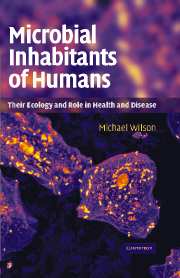Book contents
- Frontmatter
- Contents
- Preface
- Abbreviations used for microbial genera
- 1 An introduction to the human–microbe symbiosis
- 2 The skin and its indigenous microbiota
- 3 The eye and its indigenous microbiota
- 4 The respiratory system and its indigenous microbiota
- 5 The urinary system and its indigenous microbiota
- 6 The reproductive system and its indigenous microbiota
- 7 The gastrointestinal tract and its indigenous microbiota
- 8 The oral cavity and its indigenous microbiota
- 9 Role of the indigenous microbiota in maintaining human health
- 10 Manipulation of the indigenous microbiota
- Index
1 - An introduction to the human–microbe symbiosis
Published online by Cambridge University Press: 06 July 2010
- Frontmatter
- Contents
- Preface
- Abbreviations used for microbial genera
- 1 An introduction to the human–microbe symbiosis
- 2 The skin and its indigenous microbiota
- 3 The eye and its indigenous microbiota
- 4 The respiratory system and its indigenous microbiota
- 5 The urinary system and its indigenous microbiota
- 6 The reproductive system and its indigenous microbiota
- 7 The gastrointestinal tract and its indigenous microbiota
- 8 The oral cavity and its indigenous microbiota
- 9 Role of the indigenous microbiota in maintaining human health
- 10 Manipulation of the indigenous microbiota
- Index
Summary
The first 9 months of our existence – the time we spend in our mother's womb – is the only period of our life during which we are free of microbes. Our delivery from this parasitic existence into the outside world exposes us to an enormous range of microbes from a variety of environments – our first encounter with life forms which have an anatomy, physiology, and metabolism very different from those of our own. Hence, our immediate companions on life's long journey include organisms from (1) the vagina, gastrointestinal tract (GIT), skin, oral cavity, and respiratory tract of our mother; (2) the skin, respiratory tract, and oral cavity of other individuals present at the delivery; (3) the instruments and equipment used during delivery; and (4) the immediate environment. These will include, therefore, not only microbes from other human beings, but also organisms from soil, water, and vegetation that may be present. All of the studies that have been carried out on neonates have shown that, within a very short time following delivery, microbes are detectable on most of those surfaces of the baby that are exposed to the external environment (i.e., the skin, respiratory tract, GIT, and oral cavity). Despite the fact that we are exposed to a wide variety of microbes at birth, only a limited number of species are able to permanently colonise the various body sites available, and each site is colonised predominantly by only certain microbial species (i.e., the microbes display “tissue tropism”).
- Type
- Chapter
- Information
- Microbial Inhabitants of HumansTheir Ecology and Role in Health and Disease, pp. 1 - 50Publisher: Cambridge University PressPrint publication year: 2004
- 2
- Cited by



